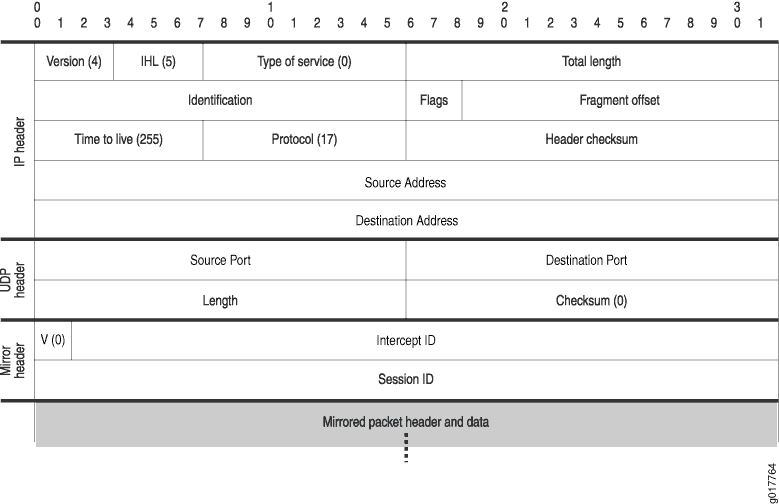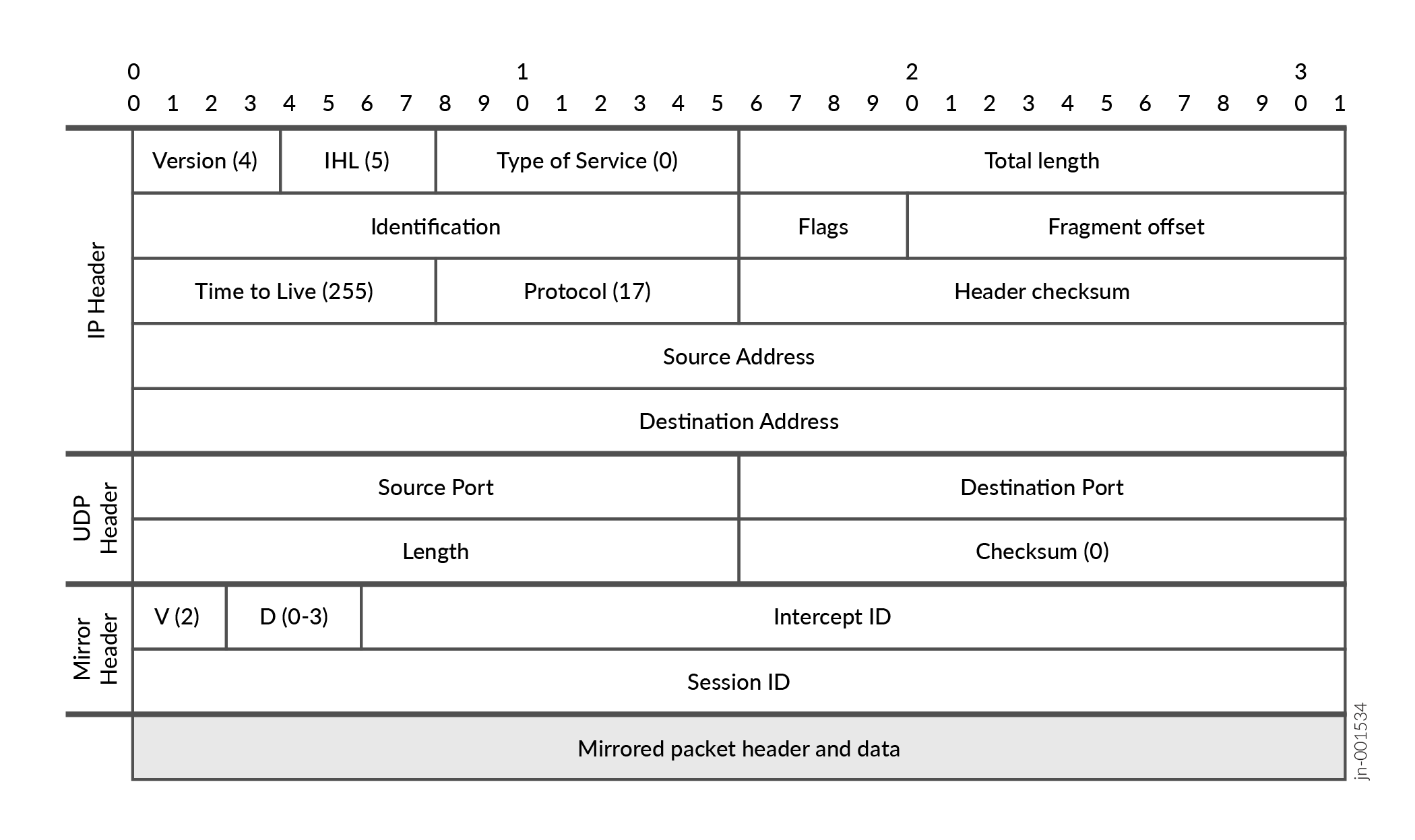Using the Packet Header to Track Subscribers on the Mediation Device
When the router sends mirrored traffic to the mediation device, it encapsulates it in a packet header. Figure 1 is the mirrored packet header and payload that the router sends to the mediation device. The packet header includes a mirror header that the mediation device can use to track subscribers and subscriber sessions. The router creates mirror header based on information that it receives from the RADIUS server.

Table 1 describes the fields in the packet header of mirrored packets.
|
Field |
Value |
Length (Bits) |
|---|---|---|
|
IP Header |
||
|
Version |
4 |
4 |
|
IHL |
5 |
4 |
|
Type of Service |
0 |
8 |
|
Total Length |
Dynamically computed |
16 |
|
Identification |
Dynamically computed |
16 |
|
Flags |
Dynamically computed |
3 |
|
Fragment Offset |
Dynamically computed |
13 |
|
Time to Live |
255 |
8 |
|
Protocol |
17 |
8 |
|
Header Checksum |
Dynamically computed |
16 |
|
Source Address |
IP address of the router interface that sends mirrored traffic to the mediation device |
32 |
|
Destination Address |
IP address of the mediation device to which mirrored traffic is forwarded (VSA 26-60) |
32 |
|
UDP Header |
||
|
Source Port |
UDP port number on the router from which mirrored traffic is sent to the mediation device |
16 |
|
Destination Port |
UDP port on the mediation device to which mirrored traffic is forwarded (VSA 26-61) |
16 |
|
Length |
Dynamically computed |
16 |
|
Checksum |
0 |
16 |
|
Mirror Header |
||
|
V (mirror header value) |
Used by the router to specify how the values of the Session ID and Intercept ID are determined. The value received from RADIUS can be 0 or 1. However, the value is always 0 in the packet header sent to the mediation device. |
2 |
|
Intercept ID |
Used along with the Session ID by the mediation device to track a subscriber across multiple login and logout events. The value is assigned to a subscriber whose traffic is being intercepted. The Intercept ID is constant; it does not change as a subscriber logs in and logs out of sessions. |
30 |
|
Session ID |
Used by the mediation device to identify the session of the mirrored subscriber. The value is assigned to a subscriber session by the Junos OS. The Session ID changes with each new session for a subscriber. |
32 |
Mirror Header Format
The values of the Intercept ID and the Session ID are determined by the value that the router receives in VSA 26-59. VSA 26-59 is declared as a hexadecimal string that can be either 4 bytes or 8 bytes long. The mirror header value specifies whether a 4-byte value or an 8-byte value is used to form the Intercept ID and the Session ID.
The VSA 26-59 is a hexadecimal format. For example, a value of 40000010 becomes 0x40000010 in VSA 26-59 format. V = 0 is denoted as V = 0x0 in hexadecimal format.
4-Byte Format
The 4-byte format allows you to manually specify the Intercept ID. The Session ID value is automatically created based on the least significant 32 bits of the Acct-Session-ID (RADIUS attribute 44).
To use the 4-byte format of VSA 26-59, configure the first two most significant bits of the VSA to the hexadecimal value of 01, where the 1st bit is 0 and the 2nd bit is 1. The 4-byte format indicates a single word in the VSA. The remaining 30 bits of the word form the Intercept ID value.
For example, a value of 40000010 for VSA 26-59 configures the following fields in the mirror header, as shown in Figure 2:
-
V = 1
-
Intercept ID = 0x10
Figure 2: 4-Byte Format of VSA 26-59
8-Byte Format
The 8-byte format of VSA 26-59 enables you to manually specify the both the Session-ID value and the Intercept ID value.
To use the 8-byte format, you configure the first two most significant bits of the first word of the VSA to a value of 0, which indicates two words in the VSA. The remaining 30 bits of the first word form the Intercept ID value, and the second word is the Session-ID field. You cannot change the order of these two words.
For example, a value of 0000030000000090 in VSA 26-59 configures the following fields in the mirror header, as shown in Figure 3:
-
V = 0
-
Intercept ID = 0x300
-
Session ID = 0x90
Figure 3: 8-Byte Format of VSA 26-59
Mirror Header Format (Junos OS Evolved with Payload Direction)
In Junos OS Evolved devices, you can enable Direction(D) field in the mirror header by
using the set system services radius-flow-tap extended-mirror-header
command. The Direction(D) field helps the mediation device to quickly identify the
traffic direction and apply the appropriate rules defined by the law enforcement
agency.

Configure the first two most significant bits of the VSA to a value of 2 to indicate that the mirror header contains the Direction field, See Mirror Header in Figure 4.
The Direction(D) field is 3-bits long. The possible values are as follows:
-
0: Reserved for keepalive mechanism
-
1: The direction of the intercepted data or event is not known to the Point of Interconnect (POI)
-
2: Intercepted data or event was sent to target (downstream)
-
3: Intercepted data or event was sent to target (upstream)
